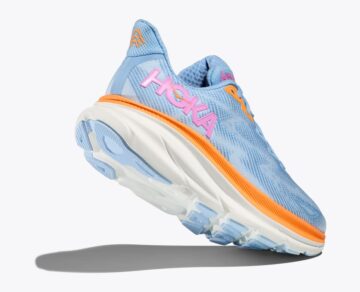The products and services mentioned below were selected independent of sales and advertising. However, Simplemost may receive a small commission from the purchase of any products or services through an affiliate link to the retailer's website.
If you’ve ever come back from a walk with sore feet or experienced foot cramping while walking, it might be your shoes. As it turns out, not all tennis shoes and sneakers are equal. In fact, you shouldn’t just be wearing generic sneakers. Walking shoes are key to ensuring a great walking workout.
Figuring out how to pick the most comfortable walking shoes might not be the most intuitive process, though. After all, there are a lot of sneakers on the market. Simplemost reached out to podiatrists and other experts to make finding your new pair of walking shoes a little simpler.
Comfort and Fit
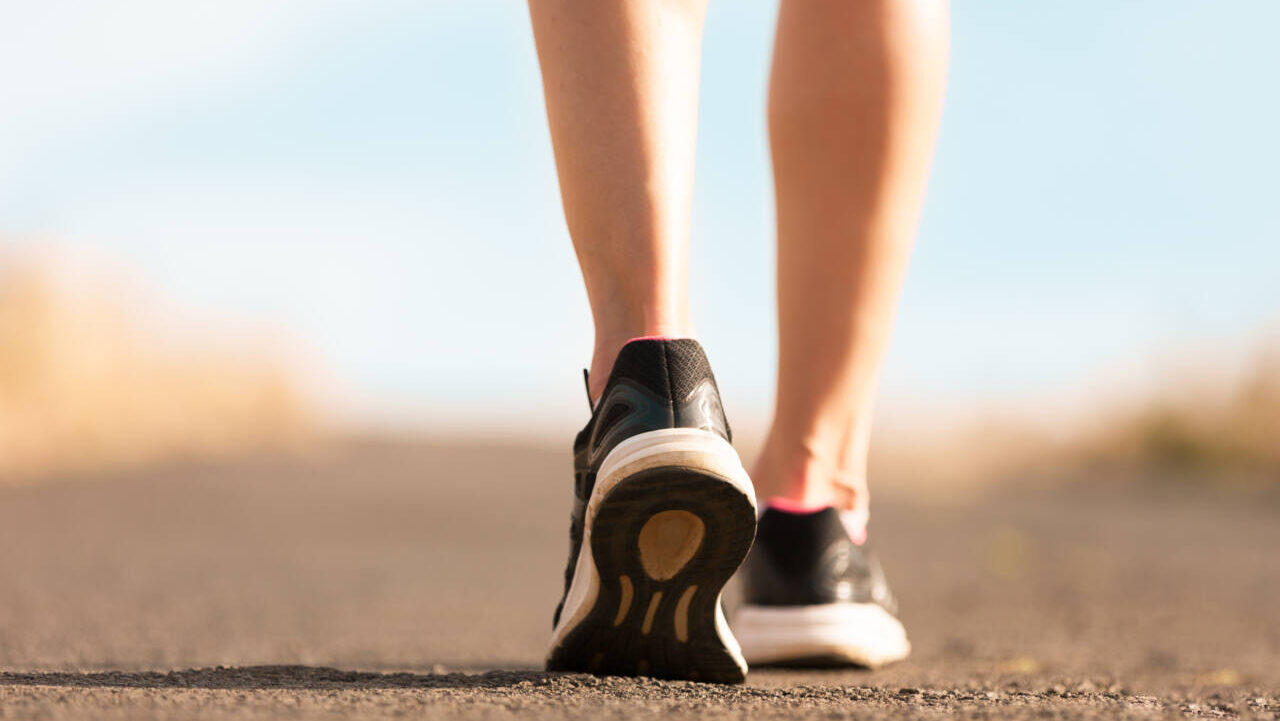
A pair of walking shoes might feel comfortable at first, but after the first few walks, you might be rethinking things. You have to pay special attention to the way walking shoes should fit. When you’re trying them on, make sure there’s some wiggle room in the toe box.
“The thickness of your thumb from the end of the toes to the end of the shoe is what’s going to make a good fit,” says Dr. David Alper, a podiatrist in Burlington, Massachusetts, and a trustee of the American Podiatric Medical Association.
And don’t just assume your foot size will be the same each time you buy a new pair. As you get older, you need to get your feet sized regularly in a shoe store.
MORE: The 7 Health Benefits Of Walking Just 20 Minutes A Day
“Our feet get bigger as we get older,” says Dr. Alper. “With women, each pregnancy adds a half size to your foot. Menopause adds a half size to your foot. The feel actually splay out.”
Support and Stability
To make sure your feet are firmly supported (without wiggling around), make sure the shoes have a relatively wide base and a firm sole.
“You shouldn’t be able to bend or twist the shoe,” says Dr. Alpert. “You want a little bit of flexibility in it, but you don’t want something that’s like a bag of canvas.”
Secondly, make sure that the shoe has a solid heel cup.
“This is really important because your heel strikes first,” says Dr. Alpert. “You want to be as stable as you can when you hit the ground. The more perpendicular the heel is to the ground, the better off it’s going to be.”
Alpert adds that you can make a shoe more supportive by adding an insert — an inner insole that runs from the back of the foot to the toe. They also don’t have to be expensive with many between the $30-$50 range.
People with ankle problems might benefit from a walking shoe with a rocker bottom (which means the outsole curves at the heel and forefoot).
“You land on the heel and roll forward,” says Dr. Dana Canuso, a board-certified podiatric surgeon in Marlton, New Jersey. “This rocking motion takes a lot of stress off of your ankle joints.”
Stack Height and Heel-to-Toe Drop
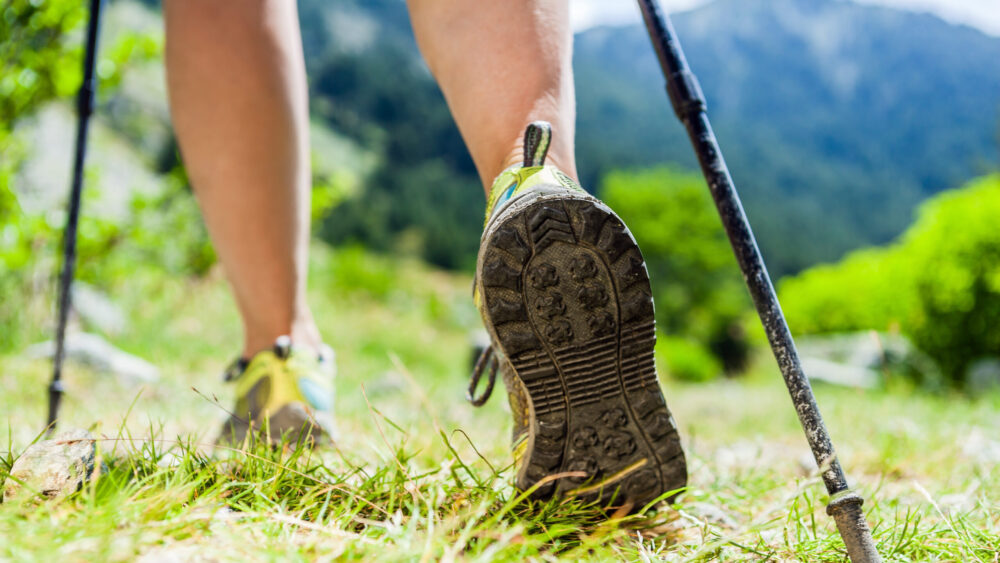
In this day and age, when thick, ultra-plush soles are showing up on practically every sneaker, it’s good to know about two other factors: stack height and heel-to-toe drop.
Stack height refers to the amount of cushioning between your foot and the ground. With a high stack height, you get lots of shock absorption but less of a feel for the ground.
“I would not recommend shoes with really plush soles for someone who’s just starting out walking because they take a bit of strength and coordination to get used to,” says Dr. Canuso.
Heel-to-toe drop is the difference between the height of the forefoot versus the height of the heel. Depending on which athletic shoe you choose, the heel-to-toe drop can range from low to high, and this affects your gait. Walking shoes tend to have a higher heel-to-toe drop than running shoes because your heel tends to strike first when walking.
With a low heel-to-toe drop, the front or middle of your foot hits the ground first, putting more pressure on your ankles. With a high heel-to-toe drop, the back of your foot tends to hit first, putting more pressure on your knees.
Do you have trouble with your ankles? Consider a shoe with a higher heel drop. Do your knees tend to hurt after walking? A shoe with a lower heel drop will shift the impact lower down your leg.
Walking Shoes for Women
HOKA Walking Shoes
You know those super plush, extra-cushioned athletic shoes you’re now seeing everywhere? They were pioneered by Hoka, which came out with their “maximalist” shoes (the Hoka One) in 2011. Marathon runners, fashion-forward sneakerheads and celebrities soon got on board, and they’ve long since crossed over into the mainstream.
But are they good for walking? Absolutely. Despite how thick and chunky they look, Hokas are truly lightweight and comfortable. The Clifton 9s have a high stack height (lots of cushioning from compression-molded EVA foam) and a relatively low heel drop of 5 mm (which means the front and back have just a 5 mm difference).
The breathable mesh comes in a large range of colors (including some very bright ones). With great arch support and a removable insole, they are an excellent choice for someone looking to log lots of steps on long walks.
Nike Walking Shoes
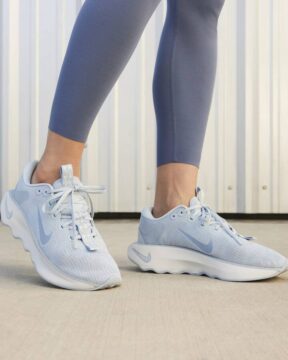
Nike’s Motiva walking shoes are aimed at people who walk for fitness — with maybe a little jogging thrown in. They’re extremely soft and bouncy, but their signature feature is the “exaggerated rocker” sole. This means that the bottom of the shoe curves, naturally propelling you forward from the foot and ankle. The outsole is also patterned to absorb bumps.
These shoes have a firm heel cup and a high heel-to-toe drop of 12 mm. They come in seven colors, ranging from neutrals to pastels to neon pink. Reviewers on the site gave these shoes an average rating of 4.5 stars and especially loved the comfy cushioning and the rocking motion, though one person did complain that the shoes made her feel like she was lunging forward.
Brooks Walking Shoes
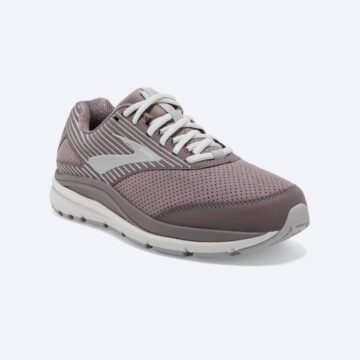
Would you like plush and cushy walking shoes that come in leather or suede? Then the Brooks Addiction Walker shoes might be for you. These shoes are known for being durable and slip-resistant, and a diagonal rollbar inside the arch helps you stay in your natural stride.
These shoes are slightly heavier than the other options here. But one reviewer on the Brooks site, Melinda M of Ohio, points out the benefit: She says they maintain their shape even when she’s on her feet all day, and this “helps keep your body aligned.”
The Addiction Walkers have a high stack height made of BioMoGo DNA cushioning (Brooks’ patented foam) and a high heel drop of 12 mm. One downside is that they don’t come in a wide range of colors, and the ones they have are fairly muted.
New Balance Walking Shoes
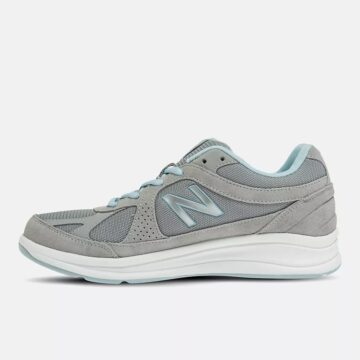
New Balance sneakers — especially the 550s — have had a recent glow-up, thanks to love from Gen Z style bloggers and certain celebrities (ahem, thank you, Taylor Swift).
The New Balance 877 V1 sneakers are highly-rated walking shoes, known for being lightweight and cushiony on pavement. They have a high stack height made of the brand’s patented Abzorb foam cushioning as well as a high heel drop of 11 mm.
The uppers are made of a stylish mixture of mesh and suede, and reviewers say they’re lightweight and breathable. The reviews also show that they’re great for people with wide feet.
FAQs
How Long Do Walking Shoes Last?
It depends on how much you use them. According to Harvard Health, many experts recommend replacing when you’ve logged 300-500 miles, which means you should get a new pair every six to 12 months if you’re walking 30 minutes a day, five days a week.
Can You Wear Walking Shoes Every Day?
That depends on how you’re using them.
“If you’re just casually walking around, that’s OK,” says Dr. Alpert. “If you work out every day, you ought to have two pairs of shoes that you alternate each day.”
Why? A combination of sweat and general stretching means that sneakers don’t revert to their original form right away. It’s best to allow them to completely dry out and stiffen up again before putting them back on.
MORE: These walking shoes have more than 55,000 5-Star reviews on Amazon
Are Walking Shoes Different Than Running Shoes?
Yes, they are designed differently, based on how your foot hits the ground. The main difference is in the cushioning, according to Dr. Canuso. Walking shoes tend to have less cushioning in the heel, and the cushioning itself is spread out throughout the shoe.
That said, most of the brands mentioned here have created shoes that can be worn for both activities. In the past, these hybrid shoes were called cross trainers. Nowadays, shoe companies simply describe certain models as good for both running and walking. In fact, most of Hoka’s sneakers fall under this category.
How to pick the most comfortable walking shoes for women originally appeared on Simplemost.com


